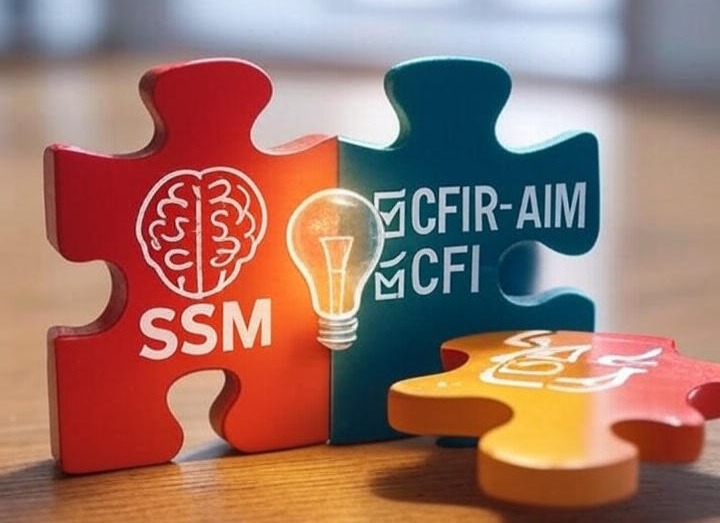Bridging Systems Thinking and Implementation Science: How SSM and Frameworks Like CFIR/RE-AIM Can Work Together

Introduction: The Limits and Strengths of Implementation Science
In the world of evidence-based practice, Implementation Science (IS) has emerged as a critical discipline—helping researchers and practitioners move interventions from theory into real-world impact. Unlike traditional research, which asks "Does this work?", IS focuses on "How can we make this work here?"—accounting for the messy realities of organizations, cultures, and human behavior.
The Dominant Frameworks: CFIR, RE-AIM, and Beyond
To tackle this challenge, IS relies on structured frameworks that break down implementation into measurable components. Two of the most widely used are:
The Consolidated Framework for Implementation Research (CFIR)
A "diagnostic tool" that identifies why an intervention succeeds or fails across five domains:
- Intervention characteristics (e.g., adaptability, cost),
- Outer setting (policies, community needs),
- Inner setting (organizational culture, resources),
- Individuals involved (staff attitudes, skills),
- Implementation process (planning, execution).
- Example: A hospital uses CFIR to uncover why a new sepsis protocol failed—revealing poor staff training (inner setting) and lack of leadership buy-in (individuals).
The RE-AIM Framework
- Evaluates real-world impact across five dimensions
- Reach (who engages with the intervention),
- Effectiveness (does it work in practice?),
- Adoption (do settings/staff adopt it?),
- Implementation (is it delivered consistently?),
- Maintenance (does it last?).
- Example: A public health study uses RE-AIM to assess why a diabetes prevention program thrived in urban clinics but collapsed in rural ones due to low adoption by providers.
The Problem: Structured Frameworks Can Miss the "Why" Behind the "What"
While these frameworks excel at categorizing barriers, they often struggle with:
Complex, subjective tensions (e.g., power dynamics, conflicting stakeholder worldviews),
Emergent system behaviors that don't fit neatly into predefined domains,
Contextual nuances that quantitative metrics might overlook.
This is where Soft Systems Methodology (SSM)—the focus of our first article—becomes indispensable. SSM's strength lies in uncovering the hidden human and systemic factors that structured frameworks might gloss over. But what if we didn't have to choose?
The Opportunity: A Hybrid Approach
In this article, we'll explore how combining SSM with IS frameworks creates a more robust approach:
SSM diagnoses the qualitative, systemic roots of implementation challenges,
CFIR/RE-AIM translates those insights into actionable, measurable strategies.
By the end, you'll see how these seemingly divergent methods don't just coexist—they complement each other, offering a richer path to sustainable change.

The Role of Soft Systems Methodology (SSM) in Implementation: Uncovering the "Why" Behind the "What"
While Implementation Science frameworks like CFIR and RE-AIM excel at structuring implementation challenges, they often operate within predefined categories—potentially missing deeper, systemic complexities. This is where Soft Systems Methodology (SSM) becomes indispensable.
How SSM Complements Traditional Implementation Frameworks
SSM, developed by Peter Checkland, is designed to navigate "wicked problems"—messy, real-world situations where stakeholders have conflicting perspectives, goals are ambiguous, and systems behave unpredictably. Unlike rigid frameworks, SSM:
Maps Subjective Realities
Uses tools like rich pictures and root definitions to visualize stakeholder worldviews, power dynamics, and hidden tensions.
Example: Before implementing a new electronic health record (EHR) system, SSM could reveal that nurses resist not because of "poor training" (a CFIR inner setting issue) but because the system disrupts their informal, trust-based workflows—a nuance surveys might miss.
Surfaces Systemic Barriers
Identifies feedback loops, unintended consequences, and cultural resistances that structured frameworks might overlook.
Example: A school-based mental health program fails not due to "low adoption" (RE-AIM) but because parents distrust external interventions—a cultural barrier SSM's root definitions could uncover.
Reframes Problems
Challenges assumptions about what needs fixing by asking how stakeholders define the problem.
Contrast: CFIR might label low staff compliance as a "training gap," while SSM could reveal it's actually a clash of values (e.g., autonomy vs. protocolization).
The Limits of SSM in Implementation Science
SSM's strength—its interpretive flexibility—is also its limitation for implementation practitioners:
Lacks prescriptive guidance (unlike CFIR's domain-based strategies).
Hard to scale without merging with measurable frameworks.
Risk of "analysis paralysis" if not paired with action-oriented tools.
Synergy in Practice: SSM + CFIR/RE-AIM
The true power emerges when SSM informs and enriches structured frameworks. Here's how:
Phase 1: SSM Exploration
Conduct stakeholder workshops to create rich pictures of the implementation landscape.
Define root conflicts (e.g., "Clinicians see the new protocol as bureaucratic, not patient-centered").
Phase 2: Framework Translation
Map SSM findings to CFIR domains:
Stakeholder tensions → Individuals involved (CFIR)
Workflow disruptions → Inner setting (CFIR)
Prioritize RE-AIM dimensions needing attention (e.g., focus on Adoption if SSM reveals cultural resistance).
Phase 3: Hybrid Intervention Design
Use CFIR to select strategies (e.g., "champions" for individuals domain), but tailor them using SSM insights (e.g., champions must be trusted peers, not managers).
Track outcomes via RE-AIM while leaving room for SSM's iterative learning.
Case Study: Vaccine Hesitancy in Rural Clinics
Problem: A proven vaccine outreach program succeeds in cities but fails in rural areas.
SSM's Role: Reveals that distrust stems from historical marginalization (not just "lack of education").
CFIR's Role: Identifies outer setting (community norms) and individuals (clinician-patient rapport) as key domains.
Hybrid Solution:
SSM-informed: Train local (not outsider) clinicians as advocates.
CFIR-guided: Monitor reach (RE-AIM) while adapting messaging via SSM feedback loops.
Key Takeaway
SSM doesn't replace Implementation Science frameworks—it grounds them in human complexity, ensuring interventions are both evidence-based and context-aware. In the next section, we'll dive into step-by-step methods for integrating these approaches.
Conclusion: Making Sense of It All
In Simple Terms:
CFIR = A checklist to figure out why something isn't working. It looks at 5 areas:
The thing you're trying to implement (is it easy to use?).
The outside world (laws, community needs).
The organization (office politics, resources).
The people involved (do they care? Can they do it?).
The process (was it planned well?).
RE-AIM = A report card to measure success. It asks:
Did the right people use it? (Reach)
Did it work? (Effectiveness)
Did places/staff actually adopt it? (Adoption)
Was it done correctly? (Implementation)
Did it last? (Maintenance)
Where SSM Fits In:
These tools are great for organizing problems—but they might miss hidden issues, like:
Why people really resist change (e.g., "This feels like more paperwork, not help").
Unspoken rules or power struggles.
SSM helps by:
Listening deeply to teams/communities to uncover the real barriers.
Drawing the big picture (like a messy mind-map) of how everything connects.
Translating those insights into CFIR/RE-AIM terms, so solutions fit the actual problem.
Bottom Line:
Think of CFIR and RE-AIM as maps—but SSM makes sure you're not navigating with an outdated or incomplete one. Together, they help turn good ideas into real-world results.
Tools like CFIR and RE-AIM tell us what to fix. SSM helps us understand why it's broken—and how to fix it with people, not just for them.
About the Editor
Paul Nunesdea is the English pen name of Paulo Nunes de Abreu, an IAF Certified™ Facilitator, Master of Ceremonies, author, and publisher of the Architecting Collaboration book series. He designs and facilitates high-impact events for corporations, public institutions, and civic organisations across Europe and beyond.
As the curator of Architecting Collaboration, Paul writes about the intersection of collaboration, facilitation, and digital transformation, drawing from decades of practical experience and system thinking. He is also the founder of col.lab | collaboration laboratory, which serves as a hub for innovation in meeting design and participatory processes, including its spin-off, Debate Exímio Lda.
In the health data space, Paul leads the Health Data Forum, a UK-registered charity advancing ethical AI adoption and digital health transformation. He spearheads the Data First, AI Later movement and manages a curated network of independent consultants specializing in health data governance and AI strategy.
